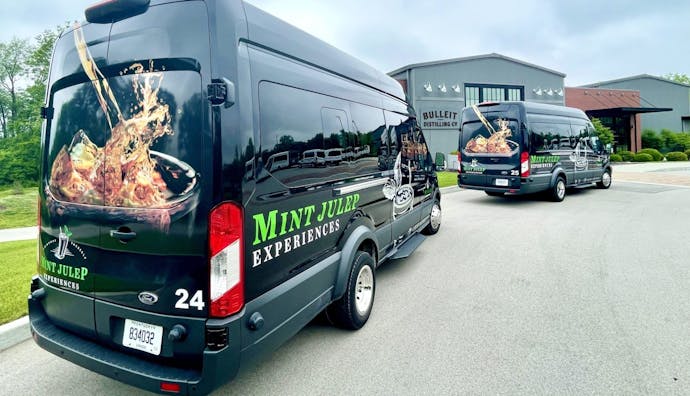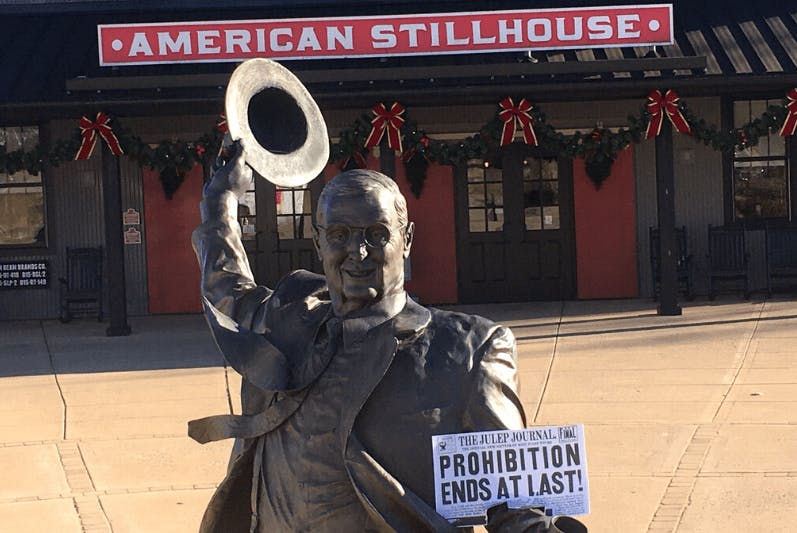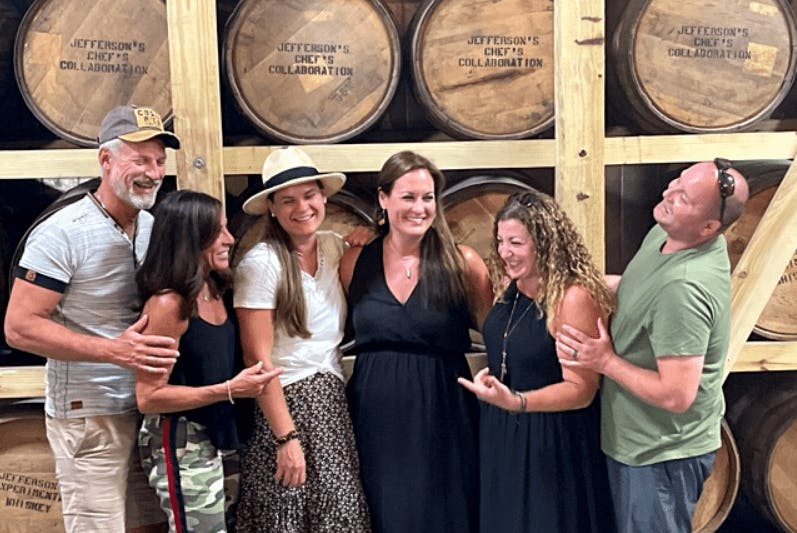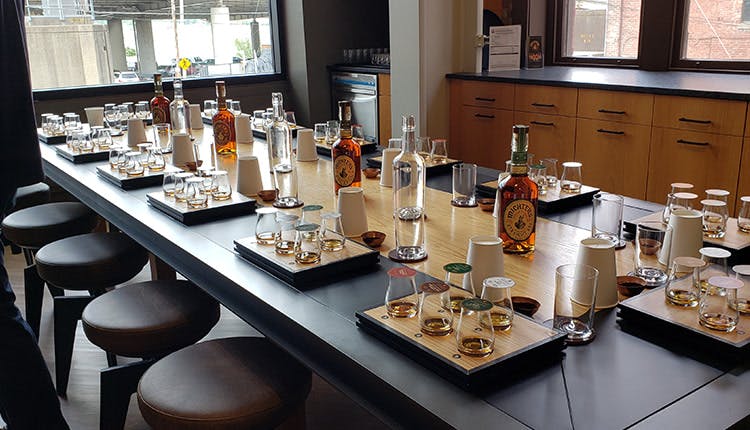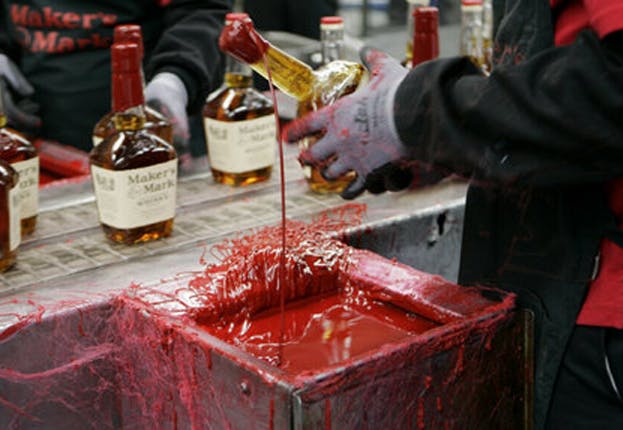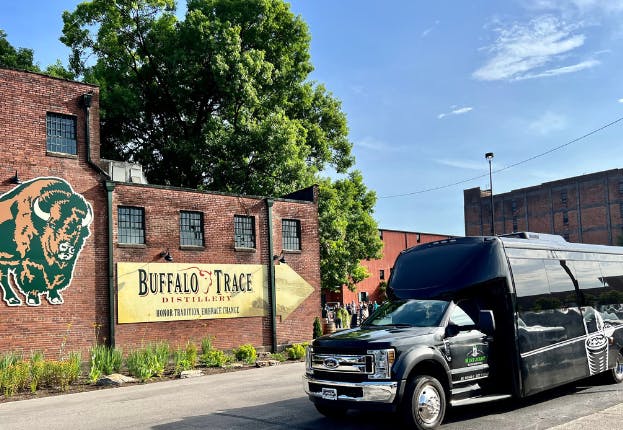The History of Bourbon Country: the Kentucky Bourbon Trail and Beyond
Bourbon, Louisville
Feb 21, 2025
- Share
The history of Bourbon Country is as deep as bourbon’s amber hue and as rich as its intricate flavors — and it serves up a shot of America’s past all centered in Kentucky.
Of course bourbon is booming today, but that hasn’t always been the case. The ebb and flow of consumer demand, along with a tragic, 13-year buzzkill known as Prohibition, dealt some major blows to the bourbon industry throughout the years. But now, thanks to the efforts of many, bourbon is here to stay and Bourbon Country is booming.
It’s enjoying a Renaissance, so to speak, and Kentucky is rolling out the amber carpet to welcome visitors near and far looking to embark on their own personal bourbon journey. After all, bourbon is personal. Bourbon is a fellowship. Bourbon is a verb.
1700s-1800s — Bourbon Begins
Although historians remain divided on exactly when bourbon was invented and where the name even derives from, we do know that Evan Williams opened the first commercial whiskey distillery in Louisville in 1783 — even before Kentucky was an official state — and that the 1800s were a booming time for the offbeat brown spirit emerging from Kentucky.
The first known advertisement for bourbon appeared in a Paris, Ky., newspaper in 1821, and by then, most of the bourbon greats had already started a distilling legacy that continues today. These bourbon pioneers included Elijah Craig, Jim Beam, George Garvin Brown (Old Forester, Brown-Forman), James C. Crow, W.L. Weller, E.H. Taylor, and Julian “Pappy” Van Winkle Sr., to name just a few.
In the late 1800s, historians believe there may have been nearly 500 distilleries dotted throughout Kentucky. And along Louisville’s famed Whiskey Row, located on Main Street, there were more than 30 distilleries and businesses related to the industry. Shipping ports were the key to a brand’s success, so you could find many distilleries along the Ohio River, from Henderson to Louisville to Maysville and beyond. If you enjoy walking the halls of history and reading about abandoned, but not forgotten cultural hot spots, check out our blog on Exploring Kentucky’s Abandoned Bourbon Distilleries.
1920-1933 — Prohibition Decimates the Industry
January 17, 1920 was the night that the lights went out in most distilleries in the United States, as the Volstead Act, also known as Prohibition, began. Bars and liquor stores shuttered their doors, brewers and distillers stopped production and sold off their equipment, and the country braced itself for 13 long years of an uptick in organized crime, sneaky speakeasies and no drinking whatsoever, sort of.
There were six whiskey producers in the country that were permitted to continue operations for medicinal purposes, including Brown-Forman, Frankfort Distillery (Four Roses), Schenley Distillery (now Buffalo Trace), National Distillers (now Castle & Key), Glenmore Distillery (Sazerac) and A. Ph. Stitzel Distillery (now Stitzel-Weller).
A person simply had to go to their doctor with a mild — or most likely fake — ailment, and they could get a prescription for a pint of spirits every 10 days. Let’s just say a whole lotta people were ill during the 1920s, because physicians wrote about 11 million prescriptions during that time.
Thankfully, on Dec. 5, 1933, Prohibition ended with the passage of the Twenty-first Amendment, and then it was time for distillers to get back to work, rebuilding their distilleries and reigniting the bourbon industry.
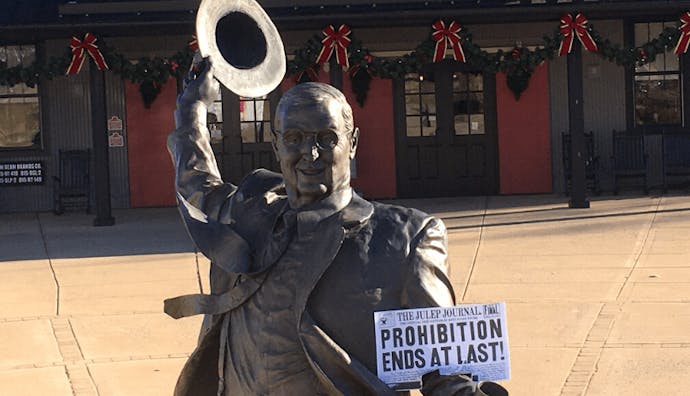
1930s-1950s — Bourbon Bounces Back
Of course, it took some time for bourbon to regain its footing in the spirits industry because it’s an aged product, after all. Plus, distilleries had to be rebuilt or newly constructed, and by that time America was knee-deep in the Great Depression.
Legend has it, however, that one former distiller was so determined to get his bourbon production up and running that he and his friends built a distillery from scratch in just 120 days. That legendary distiller was Jim Beam, and he was 70 years old. He even waited two more years to drink alcohol while his bourbon aged, finally celebrating with a sip in 1935.
That same year, the Shapira brothers of Bardstown decided to invest in a bourbon company from the ground up, taking a big risk because there was no inventory, no warehousing and not even a single brand. That distillery was Heaven Hill, and today it is the sixth largest spirits-producing company in America.
By the early-1940s and on through the late 1950s, nearly 100 distilleries in Kentucky were cranking out America’s only native spirit in record numbers, and consumers were enjoying the rich flavors of bourbon whether over ice or in popular cocktails like the Old Fashioned or Manhattan.
1960s-1980s — Bourbon Takes a Vodka Vacation
In 1964, the U.S. Congress declared bourbon to be a “distinctive spirit of the United States,” but by then, the brown spirit was quickly losing favor to lighter spirits like vodka, gin, beer, wine coolers and tequila.
The younger generation wanted anything but what their parents drank, and fad diets became all the rage, making it easy to market a light vodka drink over a sugary Old Fashioned. Whiskey distillers panicked and lowered the price on most of their products, thus cheapening their prized spirit and creating a “lesser than” attitude toward bourbon worldwide.
Sadly, many distilleries closed up shop, and many brands were lost forever during this time. Some historians refer to this period as the Dark Ages of Bourbon.
1990s — Bourbon Bites Back
As bourbon’s popularity slowly dwindled, some of the astute distillers decided to mimic what scotch makers were successfully doing by focusing on premium products instead of bottom-shelf bottles. These distillers have succeeded by leaving their mark in bourbon history.
In 1984, a master distiller by the name of Elmer T. Lee released the modern era’s first single-barrel bourbon with Blanton’s. Lee worked at the Ancient Age Distillery, which is now where Buffalo Trace sits. The premium release was named after Albert B. Blanton, who built the distillery’s first metal-cladded warehouse, which is where Blanton’s is still aged today.
Several other distilleries adopted this “luxury bourbon” idea, which drove the prices of bourbon back up and also gave birth to label verbiage like small batch, the aforementioned single barrel, age statements and the like.
Master Distiller Booker Noe at Jim Beam launched Booker’s in 1987, an unfiltered, uncut and straight-from-the-barrel, high-proof product. And in 1992, he came out with the Small Batch Bourbon Collection that included Baker’s, Basil Hayden’s and Knob Creek.
These special releases helped change the minds of consumers throughout the country and the world, proving that bourbon can be just as rich, high-quality and intricate as any other whiskey on the market.
Of course, Kentucky was the bourbon epicenter back then — and still is — and the state began to see an influx of bourbon tourism.
1999 — Kentucky Bourbon Trail® Launches
Back in the early days of bourbon’s current boom, the Kentucky Distillers’ Association (KDA) recognized a need to create and organize a tourism component that would tie the distilleries together — much like California’s Napa Valley experience. So, in 1999, they created the legendary Kentucky Bourbon Trail®, a self-guided map and passport program that featured six distilleries: Buffalo Trace (which is no longer a member of KDA or the Kentucky Bourbon Trail®), Four Roses, Heaven Hill, Maker’s Mark, Wild Turkey and Woodford Reserve.
The idea was for folks to collect stamps at each distillery they visited, and then they could turn the passport in for a prize — usually a T-shirt and a certificate of accomplishment.
The KDA reported significant interest that first year and each year after, and its numbers have only grown. In 2012, they added the Kentucky Bourbon Trail Craft Tour®, and now, both passports combined feature 38 distilleries.
The KDA states on the website that the Kentucky Bourbon Trail® and Kentucky Bourbon Trail Craft Tour® “have drawn more than 2.5 million visitors from all 50 states and 25 countries in the last five years and have become leading educational and tourism attractions.”
Keep in mind the distilleries on the Kentucky Bourbon Trail® and Kentucky Bourbon Trail Craft Tour® are spread out across the state. While doing your research and planning for your Kentucky Bourbon Trail® road trip, you may want to speak with a local Kentucky destination management company to discuss your interests and needs. You may find that a public bourbon tour fits in perfectly with your timeline and distillery interests, visiting 2-3 distilleries on the trail for a full day outing. On the other hand, you may desire a more customized bourbon experience that allows you the freedom to set your own itinerary, transportation and activities (like a mixology class or progressive dinner with bourbon pairings!), and the freedom of the stress and hassle that goes along with planning your own DIY bourbon tour.
Below are members of the Kentucky Bourbon Trail® and Kentucky Bourbon Trail Craft Tour®
Kentucky Bourbon Trail® Members
- Angel’s Envy
- Bardstown Bourbon Company
- Bulleit Distilling Company
- Castle & Key
- Evan Williams Bourbon Experience
- Four Roses
- Heaven Hill
- Jim Beam
- Lux Row
- Maker’s Mark
- Michter’s
- Old Forester
- Green River Distilling
- Rabbit Hole
- Stitzel-Weller
- Town Branch
- Wilderness Trail
- Wild Turkey
- Woodford Reserve
Kentucky Bourbon Trail Craft Tour® Members
- Barrel House
- Bluegrass Distillers
- Boone County Distilling
- Boundary Oak
- Casey Jones
- Dueling Grounds
- Hartfield & Co.
- James E. Pepper
- Kentucky Artisan Distillery
- Kentucky Peerless
- Limestone Branch
- Jeptha Creed
- MB Roland
- Neeley Family
- New Riff Distilling
- Old Pogue
- Second Sight
- Willett Distillery
- Preservation Distillery
2008 — Louisville Creates the Urban Bourbon Trail
In 2008, Louisville was seeing an uptick in tourists looking to tackle the Kentucky Bourbon Trail, with area hotels reporting outstanding numbers. But there was only one problem: They weren’t spending much time or money (other than the hotel) in the city.
The creative folks at the Louisville CVB got together and came up with the Urban Bourbon Trail, a similar concept to the Bourbon Trail, but instead of distilleries, people would explore Louisville’s wide array of cocktail bars, collecting stamps along the way in a passport.
The mayor soon got behind the initiative and even declared the Old Fashioned as Louisville’s Official Cocktail, making it a staple on cocktail menus all throughout the city — from lavish lounges to dressed-down dives. It’s worth noting that Louisville is only the third city in the country to declare an official cocktail. The first was New Orleans with the Sazerac, and the second was Washington, D.C., with the Rickey.
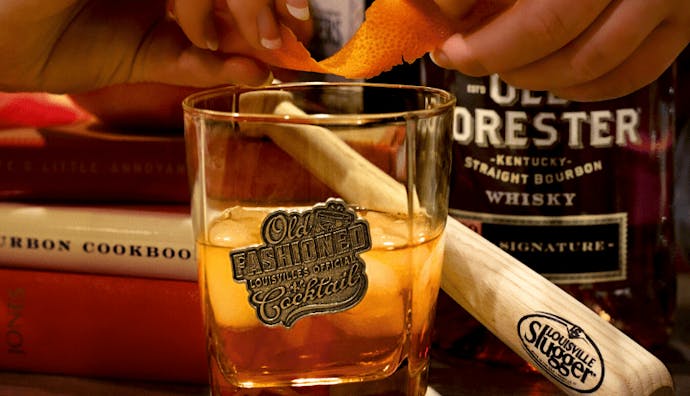
The first iteration of the Urban Bourbon Trail passport included only a handful of bars and restaurants. But now, there are more than 40 establishments one can visit to collect six stamps to turn in for a prize. The criteria for a bar to be added to the passport includes having at least 60 bourbons or more on the shelf and offering a version of the Old Fashioned on the menu.
Highlighting the cocktail culture in Louisville also harkens back to a time, just before Prohibition, when the city was once considered the “Wall Street of Whiskey.” More than 50 spirits-related businesses thrived downtown along Main Street, termed Whiskey Row, due to its proximity to the Ohio River and the wharf, where goods were shipped in and out.
And with all that hustle and bustle, of course there were taverns and bars serving bourbon by the jugful. The Pendennis Club was a popular membership-only establishment where some historians believe the Old Fashioned cocktail was first invented by bartender Tom Bullock, who went on to publish “The Ideal Bartender” in 1917. The Louisville Visitor Center, 301 S. Fourth St., has a mural dedicated to Bullock where people can take photos and pay tribute.
The Louisville cocktail bar landscape has evolved quite a bit since then, but two things remain the same: The venues serve up a great deal of Kentucky bourbon and Southern hospitality. Only four of the 40 or so bars included on the Urban Bourbon Trail have been there from the very beginning: Bourbons Bistro, Proof on Main, the Brown Hotel Lobby Bar, and the Old Seelbach Bar.
Other popular bars included in the most current edition of the passport are Merle’s Whiskey Kitchen; Jockey Silks Bourbon Bar; Momma’s Mustard, Pickles & BBQ; River House Restaurant & Bar; Taj Louisville; Charr’d Bourbon Kitchen & Lounge; and Buck’s; among many others.
Before the 2020 pandemic, the Louisville CVB was working on an app that would act as a virtual passport, but that has been put on hold temporarily while the service industry gets back on its feet. So for now, stay tuned for Urban Bourbon Trail updates and additions.
Experience the Urban Bourbon Trail for Yourself
Explore downtown Louisville’s bourbon scene with a guided and scheduled tour of Urban Bourbon Trail distilleries. Get exclusive reservations and tasting lineups when you book with Mint Julep Experiences. Or if you’re more of a DIY explorer, get yourself the Urban Bourbon Trail Passport to guide you.
2008 — Mint Julep Tours Takes to the Trail
It didn’t take long for two Louisville entrepreneurs to realize that as more tourists flocked to Kentucky, there was a need for custom transportation along the Kentucky Bourbon Trail® and beyond.
So in 2008, Sean and Lisa Higgins created Mint Julep Tours to offer guests a one-of-a-kind elevated bourbon experience in which they didn’t have to worry about driving, securing tickets or seeing the best Kentucky has to offer on all the backroads, highways and byways throughout Bourbon Country.
Mint Julep started with one van the Higgins kept in their driveway, and now they’ve expanded to a fleet of more than 25 and a staff of more than 30. Now referred to as Mint Julep Experiences, the company has also expanded to Nashville Tours and is sharing its Southern hospitality with folks looking to explore the burgeoning Tennessee Whiskey Trail®, the legendary Jack Daniel’s Distillery, Nashville cuisine and the most popular Nashville murals.
On bourbon tours with Mint Julep Experiences, guests can expect guided transportation, a bourbon expert to share Bourbon Country history and fun facts, and distillery tours with tastings. The hassle of planning and purchasing tickets, keeping track of time and arranging safe transportation is taken off your shoulders and handled completely by the Mint Julep Experiences team. In addition to public and custom bourbon experiences, guests can book food tours and progressive dinner events, horse farm tours and Kentucky sightseeing tours with Mint Julep Experiences.
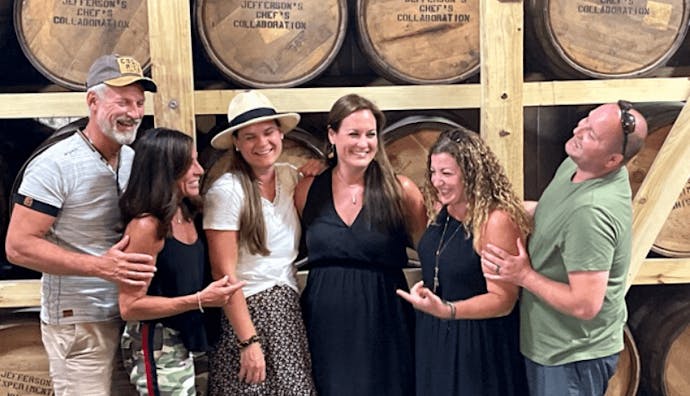
2000s-Present Day — Bourbon Country Blossoms
As demand for bourbon increases worldwide — domestic sales surged 40% in a five-year span — and Kentucky tourism is at an all-time high, the Bourbon Country landscape expanded each year with new distilleries both big and small.
There are now at least 60 distilleries in Kentucky, and most have sprung up along the distillery trail triangle between Louisville, Lexington and Bardstown. And new distilleries are announced each year, with global spirits companies like Diageo, Bacardi, Stoli and Pernod Ricard purchasing ownership in some as well.
While some have questioned the Bourbon Boom’s longevity, others have put their faith — and investments — in bourbon’s well-earned place on the bar shelf of life indefinitely. Bourbon isn’t going anywhere, and neither is the passion, fervor and respect the spirit evokes worldwide — from the thousands of men and women in the industry to avid aficionados and casual consumers alike.
